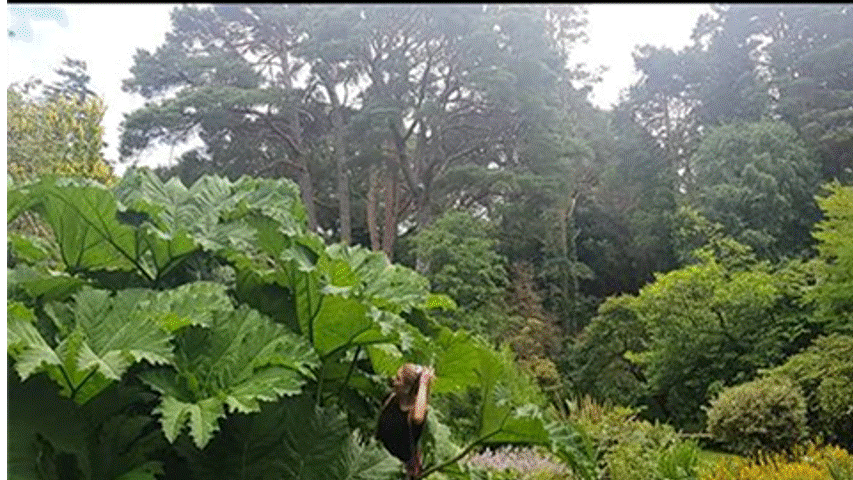Gunnera tinctoria or commonly known as giant rhubarb ironically has no relation to rhubarb whatsoever. It does, however, resemble it in looks which is where it got its common name for giant rhubarb from. It is a large plant and has thorny stems and leaves, which acts as a defence mechanism against herbivores. In winter, the leaves die back and expose large buds gathering on the plants’ rhizomes above the soil surface; it can grow up to 2 meters tall. It is commonly more noticeable in the spring and summer large ‘umbrella’ shaped leaves. It commonly establishes itself along coastal cliffs, waterway, older run down and overgrown gardens and fields. (Fennell et al 2012)
Gunnera tinctoria was introduced to Ireland by gardeners as the “giant rhubarb” was seen as an ornamental plant for gardens. It is a plant which is native to South America but is now invasive in Europe North America, New Zealand and Australia. It was often the case during the period of explorations , when explorers would travel all over the world on a boat to find the most exotic and foreign plants to bring back to Ireland, often was seen as a sign of wealth and good fortune when these exotic plants appeared in the gardens of lords and ladies of the time. Since then the Gunnera tinctoria species has become well adapted to the Irish climate. It is becoming more important to understand the spread of invasive species in countries which are outside the plants native regions., there is increasing due effects on ecosystem functioning and global biodiversity due to invasive species (Wilcove et al 1998) Gunnera tinctoria was successfully introduced into Ireland via a suitable vector , as this species was primarily introduced for gardening , its main transport vector was humans mainly via boats , this species was potted , planted and watered in order for them be to successful introduce into gardens. As it is often seen along waterways ,water is also another vector of its dispersal and why it is spread along stream , ditches and rivers. (Gioria, 2007)
Invasive species generally impact the environment, human health and have economic consequences in the area it grows. Gunnera tinctoria has been known to cause economic problems such as blocking pipes which help drainage, clustering ditches and also access ways for people which can be expensive to get removed. The species is considered invasive on the Achill Islands of Ireland, but not a major threat in the rest of the island. It is used for decretive purposes in tourist places such as Muckross house gardens, and in many gardens of manors around Ireland. It can also have biodiversity impacts in areas where it becomes well established as it is large introduced plant species can form dense colonies with up to 20 plants per colony creating a canopy of shade as the species has such large leaves it prevents the sunlight from reaching the ground, preventing ground level species from developing.
In some parts of the world, the Gunnera tinctoria is being uprooted, but other ways to prevent its spread is by not swapping cuttings of the plant with other gardeners, never collect cuttings from the wild, promote native species by planting them instead of Gunnera tinctoria in gardens.

References
Wilcove, D.S., Rothstein, D., Dubow, J., Phillips, A. and Losos, E., 1998. Quantifying threats to imperiled species in the United States. BioScience, 48(8), pp.607-615.
Fennell, M., Murphy, J.E., Armstrong, C., Gallagher, T. and Osborne, B., 2012. Plant spread simulator: a model for simulating large-scale directed dispersal processes across heterogeneous environments. Ecological modelling, 230, pp.1-10.
Gioria, M., 2007. The impact of three invasive species on soil seed bank communities (Doctoral dissertation, University College Dublin).